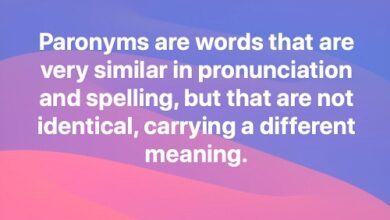What is Meaning
Meaning of Meaning
Meaning is the meaning or meaning of a word or an expression. The term comes from the verb mean , linked to the sign of an idea or something material and to what, by convention or imitation, represents something else.
For example: “It is difficult to explain the meaning of love” , “The meaning of stool refers to a seat without backrest or arms” , “I do not understand the meaning of the phrase pronounced by the character at the beginning of the scene” , “In the school I learned the meaning of several words in French ” .
The meaning can also be something that is meant in a certain way : “Only now can we understand the meaning of that celebration of the Argentine player” , “The attitude of the president had a very special meaning for newly arrived immigrants” , “We must judge the act by its symbolic meaning and not by its participants ” .
Throughout our growth, we usually give more meaning to certain memories , as we acquire more tools to understand our life and our environment. It is not uncommon to discover in adulthood that we finally understand an attitude that our parents or grandparents had, for example, during our childhood; This can be positive or negative, since it can reveal a terrifying truth or help us forgive someone who, despite what we have believed in the past, had no intention of hurting us.
For linguistics , the meaning is the semantic content of a sign . This content is conditioned by the context and the system in question. The meaning is established from its relationship with the signifier in the linguistic sign .
Ferdinand de Saussure argues that meaning is a concept that, when associated with an acoustic image (a psychic imprint in the mind), creates the linguistic sign (the minimum unit of a sentence).
Charles Sanders Peirce , another expert in semiotics, understands meaning as an abstraction or mental image that joins the signifier (the material support captured by the senses) to form the linguistic sign, which refers to a referent (real object).
Dreams meaning
Since time immemorial, the world of dreams has represented the closest contact that all human beings can have with magic. Incredible experiences that we can live every day, anytime we decide to sleep; encounters with loved ones that we have lost along the way or with those who have hurt us a lot; trips to sites that we have never visited, either due to lack of resources or because, in reality , they are not part of this planet.
It is worth mentioning that not all people remember their dreams , and that many achieve it only on special occasions; For them, this interdimensional walk may not seem as fascinating as for those who do it regularly and intensely every night, every afternoon during the nap. Those who have the fortune to dream, as if it were to see short films made to measure at each time of rest, crave it, need it, and it is the meaning of these stories that most intrigues them.
There are many sources of information about the meaning of dreams, which attempt to explain the most common symbols, including death, the presence of a baby, the feeling of flying, water and the inability to escape running from a danger.
Despite the attempts of many specialists from various fields to explain the meaning of people’s dreams (it should be mentioned that the rest of the animals also dream) it is necessary to take into account that these stories that we live each time we sleep are built to from our own experiences, from the living beings that have passed through our lives, from our needs and frustrations, from our deepest fears and desires, so that this information should be taken as a guide and not as an immovable truth.
TYPES OF MEANING
a. Conceptual: content communicated by denotation
b. Associative
1. Connotative: The information transmitted through the associations induced by the referred object.
2. Stylistic: The transmitted through the associations induced through the circumstances of use of language.
3. Affective: The transmitted through the mood associations that involves the use of language.
4. Reflection: The transmitted by virtue of the associations with other denotations of the same expression.
5. Conlocative: The transmitted by the association of the expression used with others next to which it usually appears.
Meaning and Significant
According to Ferdinand de Saussure, the linguistic sign is an entity constituted by the signifier and the meaning. The signifier is the material or sensitive component of the linguistic sign: it is the written word or the phoneme or the set of phonemes that are associated with a meaning. While the meaning is the semantic content of the signifier, that is, the mental representation or the concept that is associated with a linguistic sign.
Denotative and connotative meaning
As denotative meaning is called the concept or idea that a sign contains in an objective, basic and universal way. Hence, it opposes the connotative meaning , which refers to the set of concepts or ideas that a sign can evoke or awaken, in addition to that which is its own. Thus, the word blue, which refers denotatively and specifically to a color, when used in a poetic text can also have other connotations and refer to realities such as the sky or the sea, or concepts such as serenity or calm.
Literal and figurative meaning
The literal meaning is called that concept or idea that is objectively associated with a linguistic sign. The figurative sense , on the other hand, is that which is attributed to a linguistic sign when the ideas or concepts it denotes are different from those that it literally has. For example , in the phrase: “My mother has swept the living room of the house“, the verb sweeping is used with its literal meaning. Now, if we say: “We have swept the field with the opposing team”, we are using the verb sweeping figuratively to mean that we have defeated our rival in such a sweeping way.
Contextual Meaning
As contextual meaning is called that which is attributed to a word or phrase depending on the language environment in which it is used. For example , if a person who has been hit with a pillow by a friend says “this is war,” by context we know that it is simply a playful and friendly fight with pillows. Now, if the person who says so is the head of state of a nation before the media, we know that the seriousness of the matter is much higher, since it is the beginning of hostilities between two countries.



